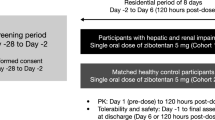Summary
The pharmacokinetics of lansoprazole (L) after a single oral dose of 30 mg was determined in 18 healthy volunteers, 17 renal failure patients and 24 hepatic failure patients; 8 hepatitis and 16 with compensated (CC) or uncompensated (UCC) cirrhosis.
In renal failure, the absorption of L was unchanged, its half-life being similar to that in healthy subjects; a small change seen in mild renal failure patients (creatinine clearance between 40 and 60 ml/min) was attributed to the age of the patients. Urinary elimination, essentially as metabolites of lansoprazole, was decreased, in relation to the degree of renal impairment.
In hepatitis patients, the AUC and t1/2 of L were doubled, without any change in Cmax. In cirrhotics tmax was prolonged, the AUC was increased (P<0.001) and there was prolongation of t1/2 (6.1 h in CC and 7.2 h in UCC compared to 1.4 h in healthy subjects). These changes resulted from a decrease in the clearance of L. There was also an increase in its sulphone metabolite (Cmax, Rm) and a decrease in the hydroxylated metabolite (Cmax, Rm) in relation to the degree of liver disease, and reflecting a decrease in hydroxylation and biliary elimination.
Thus, renal failure had no effect on the pharmacokinetics of L, but severe hepatic failure caused marked changes. A repeated dosing study would be necessary to evaluate the repercussions of the possible accumulation in cirrhotic patients.
Similar content being viewed by others
References
Nagaya H, Satoh H, Kubo K, Maki Y (1989) Possible mechanism for the inhibition of gastric (H+/K+)-adenosine triphosphatase by the proton pump inhibition AG1749. J Pharmacol Exp Ther 248: 799–805
Muller P, Dammann HG, Leucht U, Simon B (1989) Human gastric acid secretion following repeated doses of AG1749. Aliment Pharmacol Ther 3: 193–198
Satoh H, Inatomi N, Nagaya H, Inada I, Nohara A, Nakamura N, Mahi Y (1989) Antisecretory and antiulcer activities of a novel proton pump inhibitor AG1749 in dogs and rats. J Pharmacol Exper Ther 248: 806–815
Delhotal-Landes B, Cournot A, Vermerie N, Dellatolas F, Benoit M, Flouvat B (1991) The effect of food and antacids on lansoprazole absorption and disposition. In: Aiache JM (ed) Proceedings of the 4th European Congress of Biopharmaceutics and Pharmacokinetics. Eur J Drug Metabolism Pharmacokinet, Special Issue No. 3. Medecine et Hygiène. Genève, pp 315–320
Flouvat B, Delhotal-Landes B, Cournot A, Dellatolas F (1993) Single and multiple dose pharmacokinetics of lansoprazole in elderly subjects. BR J Clin Pharmacol 36 (in press)
Delhotal-Landes B, Miscoria G, Flouvat B (1992) Determination of lansoprazole and its metabolites in plasma by high performance liquid chromatography using a loop column. J Chromatogr 577: 117–122
Author information
Authors and Affiliations
Rights and permissions
About this article
Cite this article
Delhotal-Landes, B., Flouvat, B., Duchier, J. et al. Pharmacokinetics of lansoprazole in patients with renal or liver disease of varying severity. Eur J Clin Pharmacol 45, 367–371 (1993). https://doi.org/10.1007/BF00265957
Received:
Accepted:
Issue Date:
DOI: https://doi.org/10.1007/BF00265957



